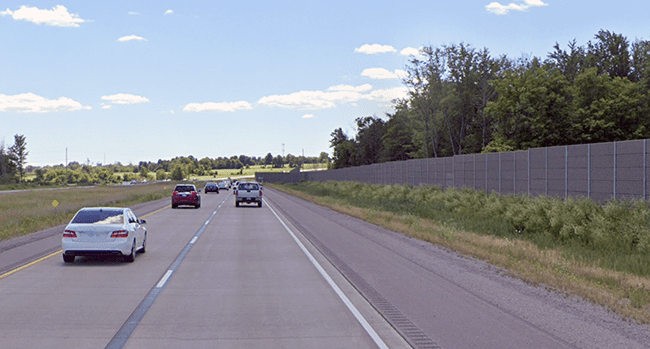Navigating Conflicting Provincial, Regional & Municipal Noise Guidelines in Ontario

Defining what constitutes a noise disturbance in the environment can be challenging and subjective, including the process of determining what level of noise is acceptable from a land-use planning perspective. The Canadian Province of Ontario is fortunate enough to have the Ministry of the Environment, Conservation, and Parks’ (MECP) province-wide NPC-300 guideline (Environmental Noise Guideline – Stationary and Transportation Sources – Approval and Planning) as a framework that sets specific definitions and criteria for noise. However, the challenge and reality are that NPC-300 isn’t the only regulation that needs to be considered during the land development process in Ontario. The applicable noise guidelines and regulations can vary greatly from location to location in the province depending on how NPC-300 is interpreted and applied at a local level.

Overlapping Noise By-laws and Guidelines for the Same Area
New land developments are often subject to the approval and review of regional and municipal levels of government. As such, many local governing bodies often have their own by-laws and guidelines that need to be taken into account, which can sometimes conflict and/or overlap with the over-arching provincial NPC-300, and thus lead to different sound level criteria, prediction procedures, and mitigation strategies being required. Some areas, like the Region of Peel, have their own regional noise guidelines. Municipalities under the region, such as the City of Brampton, can further have their own municipal-specific guidelines which are not always readily available online to discover independently and can sometimes only be acquired through direct correspondence with the municipalities or learned about after receiving comments on development applications or during pre-consultation meetings with a municipal noise reviewer. This myriad of sometimes contradictory and/or hard-to-obtain noise guidelines across all government levels in any one area can lead to a lot of confusion, if not frustration, by all parties involved in the approval process. It can also lead to unexpected approval delays.
Understanding Differing Acoustical Requirements During Land Use Planning
These layers of noise guidelines mean that land use planning may differ from an acoustical perspective depending on the project location.
Noise Criteria

The purpose of a noise study is to measure noise against established criteria to ensure a base level of human comfort and peace is achieved. The more hyper-localized guidelines can impose different noise level criteria on a development than those found in the broader provincial guidelines. An example of this can be found in the Town of Oakville’s noise bylaw, which sets out lower sound level limits for stationary noise sources, i.e. noise sources from an industrial or commercial facility, during the evening hours when compared to the limits found in NPC-300 (in this case, it is lower than the Ministry’s limit by 3 decibels).
Acoustical Tools and Methodologies
Acoustical consultants like HGC potentially have a wide array of best-practice methodologies and tools to choose from to quantify and model noise emissions. But here too, the appropriate noise prediction methodology and modeling tools, that can actually be used for a project, is limited by local review bodies’ specific guideline requirements.
Take, for example, the task of predicting the impact of road traffic noise. What might an acoustical consultant use to fulfill the task? Options available include the Ontario Ministry’s own Ontario Road Noise Analysis Method for Environment and Transportation (ORNAMENT) and Sound from Trains Environmental Analysis Method (STEAM) algorithms contained within the STAMSON noise prediction software. There is also Cadna/A, an internationally developed and recognized 3D acoustical modeling software.
While similar traffic noise analysis results and conclusions can be drawn from any of these well-known and respected modeling algorithms, not all are accepted by some local reviewing bodies.
The City of Mississauga, for instance, does not accept 3D modeling software, like Cadna/A for land use approval purposes for transportation noise. This may be because the software is expensive and not readily accessible. It also could be because some City staff may not be comfortable dealing with the complex model it produces.
The modeling parameters of the noise prediction method can also vary, as some reviewing bodies, such as the Region of Niagara are more conservative in their demands, requiring traffic volumes to be predicted further into the future (20 years rather than the typical 10 years) than the requirements of NPC-300.
Noise Control Measure and Mitigation Strategies

While NPC-300 provides guidance for appropriate noise control measures, regions and municipalities can also diverge from the provincial level school-of-thought when it comes to preferred noise control methods. At the more local level, different reviewing bodies have their own guidelines that take precedence over the provincial ones, since the municipality is often the final reviewing authority for land use planning approvals. Examples of this include the City of Brampton requiring the use of light-duty barriers at all outdoor amenity areas exposed to city collector roads regardless of predicted sound levels, and the Regional Municipality of Waterloo discouraging the use of barriers in favour of alternative forms of noise control methods such as using building setbacks or architectural component design.
In Conclusion
While municipalities and regions adopt localized noise control guidelines that are often similar to NPC-300, they can present their own unique requirements and criteria. Developments with the same layout and noise exposures can require different noise assessment, prediction, and mitigation strategies and methods depending on the location due to the nuances in the different provincial, regional and municipal-specific noise guidelines.

The key to a smooth land-use planning approval process from a noise perspective is to work with an acoustical consultant who not only understands the distinctions and the differing needs between NPC-300 and the various regional and municipal guidelines but can also help you navigate effectively and efficiently through them all. This will also ensure environmental acoustical peace and comfort for future occupants of a development and their neighbours.
